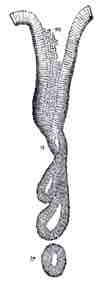The movement and the flow of chemicals into the stomach are controlled by both the autonomic nervous system and the various digestive system hormones.
The hormone gastrin causes an increase in the secretion of HCl from the parietal cells, and pepsinogen from chief cells in the stomach. It also causes increased motility (movement, peristalsis) in the stomach. Gastrin is released by G-cells in the stomach, via the base cells of the pyloric , cardiac , and fundic glands, in response to distension of the antrum, and digestive products (especially large quantities of incompletely-digested proteins). It is inhibited by a pH normally less than four (high acid), as well as the hormone somatostatin.

Fundic Gland
The fundic gland, found in the stomach, secretes gastrin and other hormones.

Cardiac Gland
The cardiac gland, found in the stomach, secretes gastrin and other hormones.

Pyloric Gland
The pyloric gland, found in the stomach, secretes gastrin and other hormones.
Cholecystokinin (CCK) primarily effects the gall bladder, causing it to contract, but it also decreases gastric emptying and increases release of pancreatic juice, which is alkaline and neutralizes the chyme. In a different and rare manner secretin, which is produced in the small intestine and primarily effects the pancreas, will also diminish acid secretion in the stomach. Gastric inhibitory peptide (GIP) decreases both gastric acid release and motility. Enteroglucagon decreases both gastric acid and motility.
Other than gastrin, these hormones all act to turn off the stomach's action. This is in response to food products in the liver and gall bladder which have not yet been absorbed. The stomach needs to push food into the small intestine only when it is not busy. While the intestine is full and still digesting food, the stomach will act as storage for food.
Epidermal growth factor (EGF) results in cellular proliferation, differentiation, and survival. EGF is a low-molecular-weight polypeptide first purified from a mouse's submandibular gland, but since found in many human tissues including the submandibular and parotid glands. Salivary EGF, which seems also regulated by dietary inorganic iodine, plays also an important physiological role in the maintenance of oroesophageal and gastric tissue integrity. The biological effects of salivary EGF include healing of oral and gastroesophageal ulcers, inhibition of gastric acid secretion, and stimulation of DNA synthesis as well as mucosal protection from intraluminal injurious factors such as gastric acid, bile acids, pepsin, and trypsin, and to physical, chemical, and bacterial agents.
The stomach can "taste" sodium glutamate using glutamate receptors. This information is passed to the lateral hypothalamus and limbic system in the brain as a palatability signal through the vagus nerve. The stomach can also sense, independently to tongue and oral taste receptors, glucose,carbohydrates, proteins, and fats. This allows the brain to link nutritional value of foods to their tastes.
Although absorption is the primary function of the small intestine, some absorption of certain small molecules does nevertheless occur in the stomach through its lining. This includes water, if the body is too dehydrated; medication, like aspirin; and amino acids (e.g., whey protein shake).
There are many different gastric glands which secrete many different chemicals. Parietal cells secrete hydrochloric acid and intrinsic factor; chief cells secrete pepsinogen; goblet cells secrete mucus; argentaffin cells secrete serotonin and histamine; and G cells secrete the hormone gastrin.